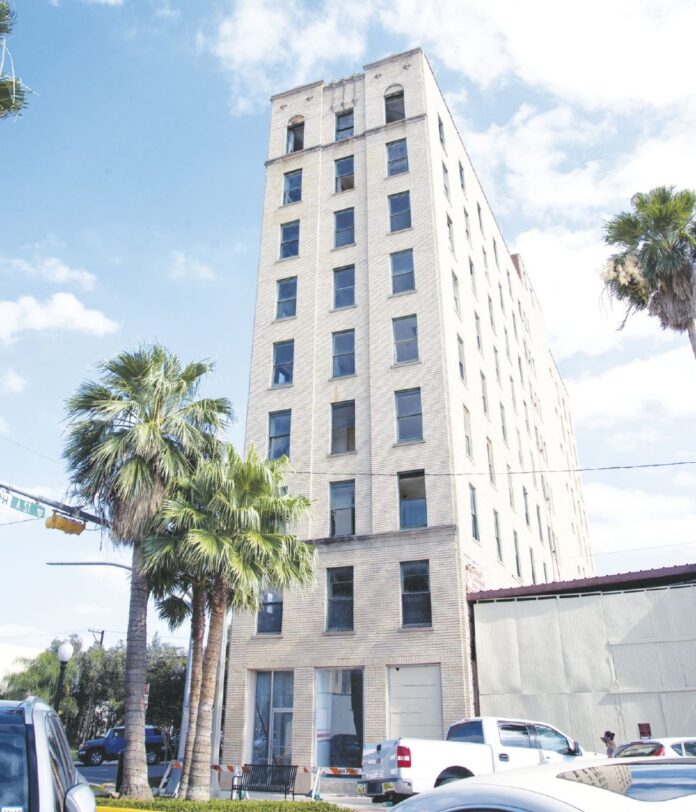HARLINGEN — For about 50 years, the city’s tallest building has loomed like a nine-story tombstone in downtown Harlingen.
Since the late 1980s, the former flop house standing at the edge of the business district billed as Historic Jackson Street has thwarted the area’s revitalization.
Yesterday, the city’s most ambitious plan to tackle the Baxter Building’s renovation finally bore fruit.
After a two-year push, developers MRE Capital, as part of a city project, clinched the cash to fund the building’s proposed $4.3 million renovation.
The Texas Department of Housing and Community Affairs awarded MRE Capital more than $3 million in federal tax credits to help fund the renovation of the former office building opened in 1927.
The agency’s board of directors granted MRE Capital’s appeal after denying the developer tax credits last month.
This year, MRE Capital re-applied for tax credits after the board denied its request last year.
Under its proposal, MRE Capital plans to use the tax credits to turn the building into a 24-unit apartment development largely made up of low-income housing.
As part of the project, the developer plans to renovate the building to its original condition.
Mayor Chris Boswell had turned the project into one of his administration’s biggest goals.
“I really feel great to have been able to convince the board to fund the project and grant the appeal,” Boswell said after the hearing in Austin yesterday.
“It’s something we’ve had as a goal for the last 10 years that I’ve been mayor,” Boswell said. “It’s more like a 30-year project to try to see the downtown revitalized. You feel a personal sense accomplishment.”
Boswell described the project as the crowing touch to the downtown area’s revitalization.
“I think this is a great thing for the city and the downtown,” Boswell said. “It’s $4.5 million invested in that building to bring it to life — to turn that nine-story eyesore into a beautiful building.”
But many downtown property owners still stand opposed to the project.
“The downtown has survived hurricanes, peso devaluations and general mayhem,” said Bill DeBrooke, the owner of several downtown buildings who spearheaded the area’s revitalization drive in the late 1980s. “It will survive this.”
DeBrooke said MRE Capital’s project will renovate the historic building that turned into a towering eyesore.
“These guys will do a good job — there’s no question about that,” he said.
But like other downtown property owners, DeBrooke said the apartment development will bring too many families into the small business district.
Downtown shop owners have expressed concern tenants will park in front of businesses, taking parking spaces from shoppers.
“The problem I’ve always had is the density of the project,” DeBrooke said. “It’s too many people in too little space.”
At the hearing yesterday, state Reps. Eddie Lucio III and Oscar Longoria stood in support of the project while state Sen. Eddie Lucio Jr. presented a letter of support.
“It was a good presentation,” Boswell said. “I’m very thankful to all who came to support the project.”
Boswell also said MRE Capital pushed hard for the project.
“The developers stuck with this project, too,” he said. “They were determined to make this happen. I thank them for their tenacity.”
City Manager Dan Serna said the developers are expected to launch the renovation project in about six months.
“There’s still design work that needs to be done,” Serna said as he drove back from Austin.
Serna said he expects the renovation project to take 10 months to a year to complete.
“We look forward to getting this project under construction and renovated,” Serna said.
How we got here
For the city, the push for the project became long and grueling.
In late 2015, the city entered into an agreement with MRE Capital to renovate the Baxter Building, one of Harlingen’s biggest eyesores blamed for standing in the way of the downtown area’s revitalization.
As part of an agreement, the developers will pay the Harlingen Community Improvement Board $250,000 for the Baxter Building while investing $4.3 million to restore it to its original condition.
Last month, the state’s Department of Housing and Community Affairs denied MRE Capital’s request for federal tax credits, arguing the developer had failed to adequately address project costs and property management and maintenance expenses as well as the 90-year-old building’s structural condition.
What changed?
But yesterday, supporters presented information that led the board to grant MRE Capital the tax credits.
“The board understood the points we were making,” Serna said. “We are very happy with the decision. It’s been a long process. We look forward to the next phase of the project.”
It was the second time the developers had requested federal tax credits to help fund the project.
Last year, the project scored low partly because prospective Baxter tenants’ children would attend Harlingen High School, which ranked below state academic standards.
Because the agency had coupled its public education criteria with its historical preservation points, the project lost critical marks.
But this year, the agency revised criteria, helping the project score high.
The state agency’s staff used its criteria to give the project 156 points, tying MRE Capital’s proposed Brownsville project while 12 other projects scored 155 points in Region 11.
November 2015 — City enters agreement with MRE Capital to renovate Baxter Building
July 2016 — Texas Department of Housing and Community Affairs denies MRE Capital’s request for federal tax credits
July 2017 — For the second time, the state denies the developer’s request for tax credits
August 2017 — MRE Capital appeals state decision
Yesterday — State agency awards more than $3 million in federal tax credits




